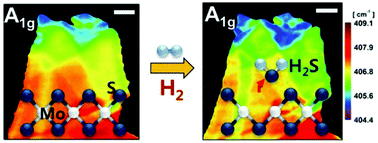Effect of sulphur vacancy on geometric and electronic structure of MoS2 induced by molecular hydrogen treatment at room temperature†
Abstract
Investigations into the interaction between molecular hydrogen and

Maintenance work is planned for Wednesday 1st May 2024 from 9:00am to 11:00am (BST).
During this time, the performance of our website may be affected - searches may run slowly and some pages may be temporarily unavailable. If this happens, please try refreshing your web browser or try waiting two to three minutes before trying again.
We apologise for any inconvenience this might cause and thank you for your patience.
* Corresponding authors
a
Interdisciplinary School of Green Energy, UNIST, Ulsan 689-798, Republic of Korea
E-mail:
noejung@unist.ac.kr
b Department of Physics, Incheon National University, Incheon 406-772, Republic of Korea
c Department of Physics and Astronomy and Department of Nano Science and Technology, Seoul National University, Seoul 151-747, Republic of Korea
d UNIST Central Research Facilities and School of Mechanical and Advanced Materials Engineering, UNIST, Ulsan 689-798, Republic of Korea
e Division of Materials Science, Korea Basic Science Institute, Daejeon 305-806, Republic of Korea
f
Department of Materials Chemistry and Engineering, Konkuk University, 120 Neungdong-ro, Gwangjin, Seoul
E-mail:
yjun@konkuk.ac.kr
Investigations into the interaction between molecular hydrogen and

 Please wait while we load your content...
Something went wrong. Try again?
Please wait while we load your content...
Something went wrong. Try again?
B. H. Kim, M. Park, M. Lee, S. J. Baek, H. Y. Jeong, M. Choi, S. J. Chang, W. G. Hong, T. K. Kim, H. R. Moon, Y. W. Park, N. Park and Y. Jun, RSC Adv., 2013, 3, 18424 DOI: 10.1039/C3RA42072H
To request permission to reproduce material from this article, please go to the Copyright Clearance Center request page.
If you are an author contributing to an RSC publication, you do not need to request permission provided correct acknowledgement is given.
If you are the author of this article, you do not need to request permission to reproduce figures and diagrams provided correct acknowledgement is given. If you want to reproduce the whole article in a third-party publication (excluding your thesis/dissertation for which permission is not required) please go to the Copyright Clearance Center request page.
Read more about how to correctly acknowledge RSC content.
 Fetching data from CrossRef.
Fetching data from CrossRef.
This may take some time to load.
Loading related content
